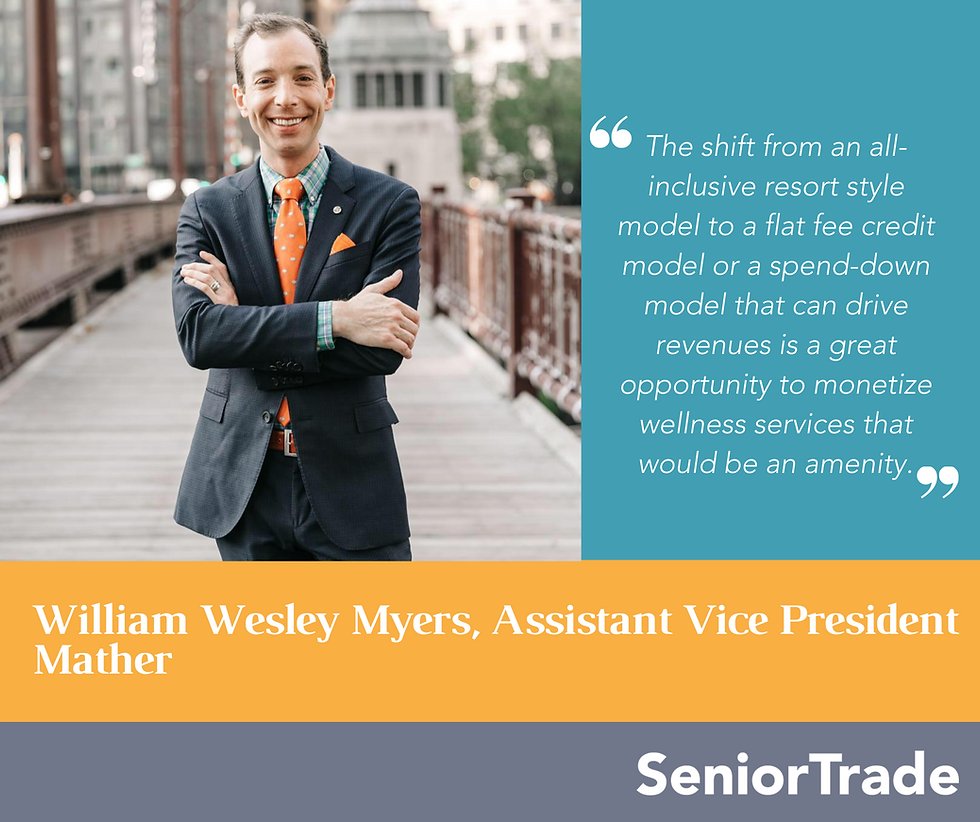New Models of Senior Wellness to Include Membership and Fee for Service
- Nancy Griffin

- Sep 5, 2022
- 3 min read
Updated: Sep 7, 2022
Mounting costs and staffing challenges are driving senior living communities to get creative about how they deliver spa, fitness, and wellness services.

As baby boomers move into senior living communities, they will demand an array of wellness services for healthy living. Mounting costs and staffing challenges are driving senior living communities to get creative about how they deliver spa, fitness, and wellness services.

William Wesley Myers, Assistant Vice President of Wellness strategies for Mather, sees senior living overcoming business challenges by adopting a fee for service model like the hospitality industry. “The shift from an all-inclusive resort style model to a flat fee credit model or a spend-down model that can drive revenues is a great opportunity to monetize wellness services that would be an amenity or a loss leader.”
Demand for Senior Wellness
Expert opinions vary when it comes the subject of wellness services such as massage therapy for older adults. In the spa industry, massage is by an overwhelming majority the most popular wellness offering for good reason. When pressure receptors under the skin are stimulated, they send messages to the brain to slow the nervous system down, which decreases cortisol and increases dopamine and serotonin. The result is a chain of positive physiological changes, including decreased heart rate and blood pressure, which cause an overarching commonality of benefits, such as reducing stress, increasing immune function and relieving pain, in a variety of disorders and diseases.

Despite these documented benefits, massage is a rarity in senior living—even at the luxury level. John Polatz, co-founder & CEO of PS Salon & Spa, thinks senior Living operators drastically overestimate how many seniors, even the younger ones, want wellness services like massage and other spa treatments beyond hair and nails. Out of the more than 1300 salons PS Salon manages within senior living, less than 15 communities around the country (a little over 1%) have a robust massage therapy offering. In more than 11 years, PS Salon has provided 3,789 massages out of 8.3 million total services in the history of the company (less than ½%.)
“In our experience, demand for wellness is essentially zero. Only the communities serving the top one half of one percent of income demographic are adding massage. It is really limited to the upper echelons of senior living,” says Polatz.
The Headaches
New cost-per-services and membership models will offset the significant operational headaches of affordably delivering senior wellness. Polatz points out the challenges of running a massage therapy program inside senior living, including staffing and financial challenges. “Being reliant on a special skills single person and replacing that LMT if they leave is a massive obstacle to being consistent in your business. As an operator, ‘the juice is rarely worth the squeeze.”
There are also a host of regulatory challenges. Some states prohibit massage in a residentially zoned building, other states allow massage but only for the occupants of the building. At the most extreme, some states like Illinois require geriatric massage to be performed by a licensed healthcare worker.
“Massage therapy is challenging both from a zoning and a licensing standpoint,” says Polatz. “In some states, massage licensure is administered by the police department instead of the state board because it is considered an ‘undesirable practice,’ with reference to either human trafficking, escort services and prostitution. There can be archaic requirements like fingerprinting and background checks for operators with greater than a 10% stake in the business. For large companies like PS Salon or a large massage franchise, that is a non-starter.”
Touchless Wellness Services
In response to the challenges of delivering hands-on services, many senior living communities are adding touchless services like salt rooms, sound therapy and hydrotherapy. Dry salt therapy is particularly suited to senior living because it acts as an anti-inflammatory, open the airway passages and increases oxygen intake. SALT Chamber has designed a dozen salt room in senior living communities.
A Staple for the Future

Developers are adding elaborate wellness facilities and programming for future projects to attract a new generation of residents and differentiate from the competition. The one size fits all model will be replaced with custom programs committed to keeping residents happy and healthy.
“There is going to be a shift in senior living as we start to see the age of entry skew younger. The demographic of the late 60’s and early 70’s has been exposed to massage and yoga and won’t give it up in their later years,” says Wendy Bosalavage, President and Chief Revenue Officer for LIVunLtd and SeniorTrade Advisory Board Member. We will see more spa and wellness facilities as innovative developers are realizing they need to be forward thinking.



Comments